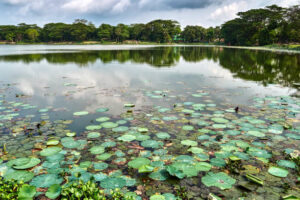
As many have noticed and commented, there has been a larger than normal accumulation of weeds hitting shorelines, swim areas and wrapping around propellers. We are not the only lake to experience this, and the unfortunate situation has a couple of causes. In conjunction with a late boating season due to the miserable weekend weather in May and June, the main reason, we believe, is called eutrophication.
An overabundance of nutrients—primarily nitrogen and phosphorus—in water starts the process. These nutrients come primarily from storm-water runoff; with the huge amounts of rain we’ve experienced steadily since December, it is not surprising. (December 23, the lake rose 15+”, due in no small part to runoff.) Other causes of the excess in nutrients can be due to fertilizers, sewage and detergents containing phosphorus. The high nutrient content allows native aquatic plants to flourish; the negative impacts are excessive “weeds”, loss of fish, an increase in algae blooms, less enticing waterfronts which threaten property values, to name a few.
To date, the “weeds” we are seeing are all from native aquatic species — waterweed, pondweed, common bladderwort, even a water marigold.
What can be done? The best way is to reduce storm-water runoff. By learning about and using erosion control strategies, we can maximize the benefit of everyone working together towards a cleaner lake.